Double-tapped circuit breakers are one of the most common electrical defects that home inspectors find. Everyone seems to sign off on this defect as a ‘big deal’, but I’m here to tell you it’s not. It’s a pretty minor issue, and it’s usually a simple and straightforward fix. Today I’ll explain what double-tapping is, when it’s a problem, why it’s a problem, and how to correct it. If you prefer video format, here’s that:
I didn’t consult with an attorney before writing this article, so I better add a disclaimer before giving any electrical how-to information: Don’t do electrical work if you’re not qualified. You could get shocked, electrocuted, or start a fire. This is only an overview.
Definition: When I say ‘double-tap’, I’m actually not using the correct terminology; this is just what a lot of home inspectors say when two conductors are connected under one screw or terminal inside a panelboard. There is no official term for this, so double-tap works for me. Sometimes this refers to two conductors at one circuit breaker, other times it refers to two conductors connected under one screw at the neutral bar. Today I’ll discuss two conductors connected to a single circuit breaker.
When it’s NOT a defect: Double tapped wiring is ok if the circuit breaker is designed for two conductors. If a circuit breaker is designed for two conductors, it will say so right on the circuit breaker, and the terminal of the circuit breaker will be designed to hold two conductors in place. The circuit breaker shown below is an older Square D designed to accept two conductors. I highlighted and enlarged the portion of the label that says two conductors can be attached. This is acceptable. The only manufacturers that make circuit breakers that are designed to hold two conductors are Square D and Cutler-Hammer, but not all of their circuit breakers can be double-tapped.
Here’s a newer type of Square D circuit breaker – instead of putting a bunch of text on the front of the circuit breaker, they just have a little picture on the front of the breaker.
They now put the text on the side of the breaker.
When it IS a defect: This is a defect when the circuit breaker isn’t designed for two conductors, and most aren’t. It doesn’t matter if it’s just a simple doorbell transformer wire that’s added onto the circuit breaker. The issue isn’t about the load imposed on the circuit, it’s about the physical connection.
Why it’s a problem: If the circuit breaker isn’t designed to hold two conductors, the conductors could come loose at some point in the future, even if they feel very tight today. Loose conductors can lead to overheating, arcing, and possibly a fire.
How to fix: The fixes I’m going to list below are a few common ways of dealing with double-tapped circuit breakers.
Pigtail: This is the most common repair, and it’s ridiculously simple. The offending conductors simply get disconnected from the circuit breaker, connected to a single conductor with a wire nut, and that single conductor gets connected to the circuit breaker. Now, I know what you’re thinking: “What’s so tough about that?” The answer is nothing. This is a quick and easy fix.
Different Circuit Breaker Another simple repair would be to replace the circuit breaker with a type that is designed for two conductors, as long as the panel is designed for it. This would be more involved than the pigtail repair, and I don’t know why anyone would want to do this, but it would certainly be acceptable.
If there are more problems going on besides just a double-tap, the repair might get more involved. For instance, if a homeowner finished off a basement and added a circuit for the basement bedroom onto the circuit breaker for the bathroom receptacles, simply adding a pigtail for the wires wouldn’t be a proper repair, in part because the bathroom receptacles can’t be on a shared circuit. In this case, the conductors would need to be split off on to two separate circuit breakers. There are a few ways to do this.
Add A Circuit Breaker If there is room in the panel, another circuit breaker can be added, and the conductors split off to the two different circuit breakers.
Install A Tandem Breaker If the panelboard is designed to use tandem breakers and a tandem breaker can be properly used in lieu of the offending circuit breaker, this is another acceptable fix. This is basically a way to install two circuit breakers in one space.
If a panel will accept tandem breakers, it will say so inside the panel, and the specific locations where tandem breakers can be used will be identified. A panel may allow all tandem breakers, no tandem breakers, or some tandem breakers. The photo below shows a panel that allows some. As you can see, eight more circuits could be added to this panel, as there are currently no tandem breakers being used. This would take some shuffling around, but it wouldn’t be a big deal to do.
For more info on tandem breakers, check out this post: Tandem Circuit Breakers
What about AFCI protection? Arc-Fault Circuit Interrupter (AFCI) protection is needed throughout homes today to help reduce the risk of fires. When a circuit breaker is replaced, is there any requirement for AFCI protection to be added at the same time? For the most part, no. But that’s ultimately the decision of the authority having jurisdiction.
When none of the above solutions are possible, the repair might involve replacement of the panel with a larger one, or the addition of a subpanel. This would be much more expensive, but still, not a crippling cost for most people.



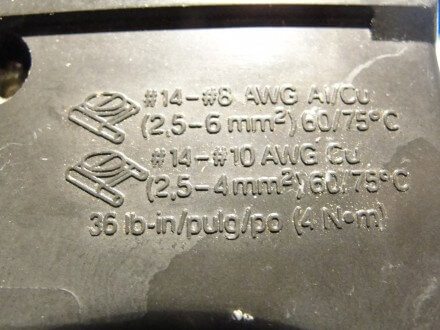
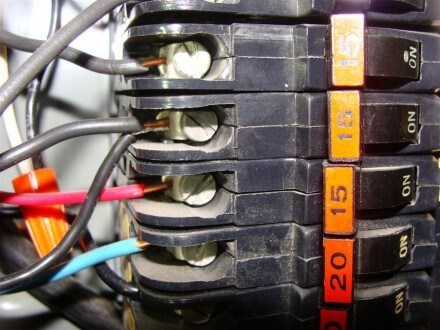
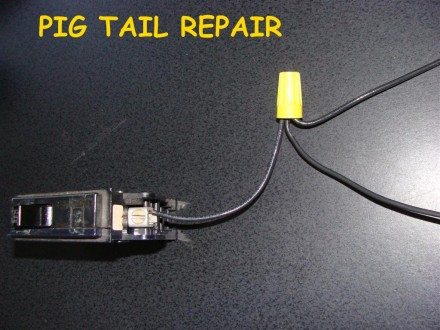
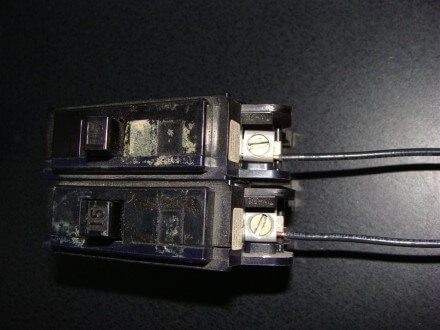
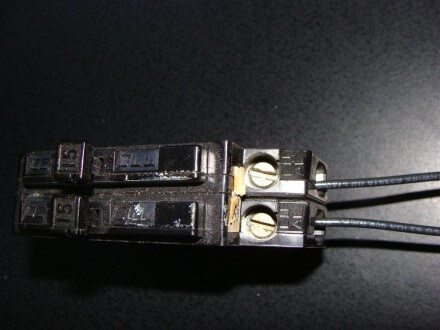
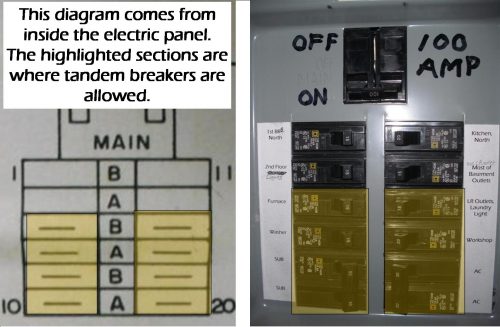

bill fuhrmann
October 1, 2019, 6:38 am
I bet that most homeowners don’t even think of the wire nut fix. We are just too accustomed to seeing every wire from the breakers heading out of the box directly.
Glad that you posted it.
Reuben Saltzman
October 1, 2019, 7:41 am
Thank you!
Wes Fahlenkamp
October 2, 2019, 6:35 am
Good article Reuben.
When using a breaker designed to hold 2 conductors, insert 2 conductors of the same size. Use 2 #12’s or 2 #14’s. Don’t use a #12 on one side and a #14 on the other side. I’ve made this mistake before, and wires have come loose over time. If you have two different size wires that go to one breaker, use the pig-tail method.
Harry Janssen
October 2, 2019, 8:42 am
Reuben,great article as always,enjoy them,keep up the good work
Jeff Carter
October 2, 2019, 12:42 pm
Another Great BlogPost. I like being able to watch you explain it, and then reading the text, to reinforce the learning. Thanks Reuben!
Ric B
October 30, 2019, 5:38 pm
Great work on sharing your knowledge to others. I had an inspection and this topic came up and I scratched my head until I watched your video and read the page. I was able to stop scratching before all my hair was gone.
Vinty
December 10, 2019, 9:52 am
I had an electrician come look at my panel and did not do any home warranty work due to a couple pigtails I have (installed by previous owners). I believe they are on wing nuts and then electric taped. Why was it a major issue when he saw it but it’s considered a proper fix in the article? Unfortunately, I don’t think I can get new breakers since mine are using GE breakers.
Reuben Saltzman
December 10, 2019, 10:32 am
Hi Vinty,
You’d need to ask your electrician why he took issue with it.
I’m not saying that this is the issue with your particular electrician, but I’ve heard that warranty work pays notoriously low rates. Contractors who come out to do warranty work typically have a huge financial incentive to find a reason to deny the warranty work, and then charge their regular rates for work that is not covered under warranty.
Again, I’m not saying this was the case with your electrician, but I’ve heard that this happens all the time.
Vinty
December 11, 2019, 5:59 pm
Thanks Reuben for getting back so quickly. When he was on site and told me about the issue, he mentioned something about backfeeding and melting wires. After googling and reading what I can find, pigtails seem fine in breaker panels. I live in a condo and the meter at the front of the condo has a main breaker of 60amps which the wires run to the sub panel located at the back of the condo. The sub panel is where all the breakers are and where he found the pigtails. There is no room for additional breakers and I assume the previous owners pigtailed a couple to make whenever they were installing work. He suggested that the sub panel be upgraded to fix the code violation before he can do any work that I requested to fix (dryer outlet is only has one hot line and an outlet’s lower receptacle not working). Is the pigtails a code violation? Does it depend what circuit is on those pigtails? Thanks again for your insight.
Reuben Saltzman
December 11, 2019, 6:45 pm
Hi Vinty, no. A pigtail is not a code violation. This could not cause backfeeding or melting of wires.
Rick Johnson
December 19, 2019, 6:19 am
when doing the pig tail method, if you have two different size wires, I figure you use the biggest of the two wire to run from the wire nut to the breaker, correct? #12 or #14
Reuben Saltzman
December 19, 2019, 8:09 am
Hi Rick, while that sounds logical, it actually won’t make any difference. The breaker needs to be sized for the smallest conductor on the circuit. If you have a 14 gauge wire on that circuit, you can’t have anything larger than a 15 amp circuit breaker. That means you can use a 14-gauge wire all the way back to the breaker.